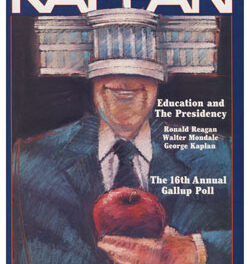
Education reforms have added choice, raised standards, and made schools safer places, but parents haven’t acquired the necessary skills to navigate this new education landscape.
Twenty years ago, parents believed they could send children to the neighborhood school with the confidence that they would get an educationally adequate and safe experience. Today, parents face a bewildering array of choices; not all are able to guarantee the security or education of the child.
Similarly, 20 years ago, parents may have been expected to attend Back to School Night, applaud at a school play, or monitor whether homework was completed. Fast-forward to 2015 where parents are still expected to do all of that plus engage in the day-to-day work of managing schools through home and school councils, press for reform through political action and neighborhood councils, and occasionally create and help manage new charter schools.
In earlier eras, parents might have been called about their child’s behavior problems, resulting in a stern talk with the wayward child and possibly a visit to the principal’s office. Now, in the era of zero tolerance, parents often are forced to advocate for a child who has acted impulsively and may face severe, long-lasting consequences as a result.
The stakes have risen dramatically over the last 20 years for parents and students, and parents’ responsibility for managing their children’s education has never been greater.
Why are these changes so significant? In our increasingly divided, postindustrial economy, knowledge workers — highly educated, creative problem solvers who “think for a living” — are at a distinct advantage. Projections of the U.S. economy in 2020 suggest that 65% of all jobs will require postsecondary education (Carnevale, Smith, & Strohl, 2013). Young people who leave school without education and training appropriate to the new demands of this economy are destined for low-wage employment. This is true for dropouts as well as those who graduate from high school with poor skills. Dropouts and graduates of our lowest-performing schools lack basic literacy and numeracy skills. They’re left without the skills required to compete in the current economy, much less the economy of the future. According to the Department of Labor, the top 10 jobs of 2010 did not exist in 2004. As our economy continues to evolve, living wage jobs that do not require a high school diploma and some postsecondary training will disappear. Moreover, pressure has increased on educators due to international comparisons and legislative pressure to increase performance. Just as the workplace continues to demand more highly skilled and educated workers with critical-thinking skills, schools continue to demand more from parents.
Parents are expected to engage in the day-to-day work of managing schools through home and school councils, press for reform through political action and neighborhood councils, and help manage new charter schools.
Not all parents can meet these new demands. Poor and working-class parents are less well-equipped both in terms of the available time and skill required to support their children in school. These parents are less able to select a good school for their child, less well-positioned to meet the demands of educators to be a “partner” in their child’s learning, have fewer of the skills (linguistic ability, math content knowledge, etc.) to assist their children in meeting educators’ demands, and are less likely to advocate for school reform (Horvat, Weininger, & Lareau, 2003; Hess & Lautzenheiser, 2012).
Parent responsibilities have changed over the last 20 years in three key areas — choice, standards, and zero tolerance. They are the same areas in which parents have displayed varying levels of ability to adapt to new demands.
Choice
Middle-class parents have long had many choices about where their children attended school, but poor and working-class families have had far more limited options. But the last 20 years have produced a proliferation of choices — charter schools, home schooling, special-selection schools including magnet schools within traditional public school districts — especially for urban parents. Having dramatically more options available has amplified the implications of school choice for parents who are somehow now expected to have the skills to evaluate the benefits of every option.
Policy makers and parents often have fundamentally different assumptions related to choice. Policy makers assume parents are in an advantageous position to select a school for their child. They believe:
- Parents know what choices are available;
- Parents can assess the advantages and disadvantages of each; and
- Parents have a useful and accurate assessment of their child’s educational needs.
Research, however, suggests these assumptions are incorrect. First, there is significant variation in parent capacity to choose. As Carolyn Sattin-Bajaj (2014) makes clear in her study of school choice in New York City, choice does not mean the same thing to all parents. Poor and minority parents often lack the time, resources, or knowledge to make informed choices, while middle-class parents typically are better-positioned to understand the system and make informed decisions. As the role of parents expands to include organized political advocacy for school reform, the capacity of all parents to effectively battle against entrenched, highly organized unions or political interests is questionable. In addition, the staying power of parents to continue to press for reform is limited. Once their child is well-situated in a school, parents are far less willing to invest scarce time, energy, and resources to advocate for changes to an entrenched system (Hess & Lautzenheiser, 2012; Cucchiara & Horvat, 2009).
Policy assumptions place many well-intentioned working-class and poor parents at a distinct disadvantage as our system has become a competitive marketplace of school choices.
Policy assumptions place many well-intentioned working-class and poor parents at a distinct disadvantage as our system has become a competitive marketplace of school choices. With a limited number of quality seats in school districts, parents are differentially able to secure their child a seat in a quality learning environment. Like an existential game of musical chairs, some children will come to rest in low-performing schools when the music stops. Some parents, usually those with more resources, understand this and have learned how to score a coveted high-quality seat for their child.
What this means for parents
Although all systems of education require some parental navigational skills, shifting from the traditional education system in the U.S. to one replete with choice options has also shifted the burden from the collective shoulders of society onto the shoulders of parents. This has increased pressure on parents, intensified competition, and altered schools’ expectations for parents. As income inequality grows in the U.S., this marketplace of choices, especially in charter dense areas leads to:
- Increased pressure to secure a viable educational setting for their child. If their child is in a “bad school,” parents are blamed for not choosing a good school.
- Increased competition among parents to secure a spot in a good school. Increased choice in an environment of increasing inequality has forced competition. Poor and minority parents are again on the losing end of that equation.
- Increased expectations for parents by schools to be more involved and activist, according to the school’s agenda. In this environment, parents get to choose, but schools also make choices including disenrollment if parents don’t meet expectations. Many charters expect parents to sign contracts that specify behavior they expect from parents.
Standards
While parents, educators, policy makers, and employers have always had a vested interest in ensuring that students are acquiring relevant and necessary skills and knowledge in schools, changes over the last 20 years have increased the pressure on educators to demonstrate the effectiveness of their instruction and its relevance to 21st-century skills and demands. International comparisons have shown U.S. students lagging other countries in academic skills, especially in math and science, and policy makers are demanding that schools become more attentive to preparing students for both college and careers. This has led to legislation that has 1) increased expectations that states adopt standards outlining what students are expected to know and understand, 2) increased reliance on single, high-stakes tests to determine if students are meeting the standards, and 3) changed how schools use data, which has increased pressure on schools, teachers, and students to improve measurable outcomes. Arguing that standards are not beneficial is difficult and foolish. The widespread adoption of the Common Core State Standards presents an unprecedented opportunity for improving instruction and student learning (Smith, Appleman, & Wilhelm, 2014). But the adoption of these standards also raises important questions and presents new challenges for educators and parents.
While the effect of the standards movement is multifaceted, widespread, and largely unknown, the single greatest game changer has been the development and adoption of the Common Core State Standards. Initially a state-led movement, the standards, which have been adopted by 45 states, are designed to make the national landscape of education more competitive with high-scoring countries, such as China and Finland. Despite the fact that research linking improved student outcomes to either standards-based curricula or high-stakes test is at best ambivalent (von der Embse & Hasson, 2012), states where the standards have been adopted have had to significantly ramp up their curricula to align with the Common Core. Testing, curricula, and teaching practices are changing in response. While test makers and textbook manufacturers will reap massive financial profits from these changes, evidence linking adoption of these standards to improved student outcomes is limited at best, and controversial in that some states now see this as a threat to local control.
Regardless of the standards adopted, schools struggle with the federal and state emphasis on testing while ensuring that students are more than a number in a state system that only seems to care about increasing scores on high-stakes tests. The point being that all the testing in the world will not help a student learn more, learn what is important, or learn how to contribute to society. Additionally, what is being done with testing is at best suspect, and most educators and parents struggle with that dilemma, especially now that teacher evaluation is being tied to student test scores. To date, the states are not evaluating how well students think, cooperate, collaborate, or problem solve — the key skills identified by universities and employers and the original intention behind the Common Core.
What this means for parents
The Common Core also has changed expectations for parents. As standards for student performance have risen and the stakes for schools have increased, educators need and want more support from parents. Schools need a different kind of relationship with parents because of standards and because funding has changed. The curriculum for math is a case in point. Most adults learned math through rote memorization, however Common Core math requires more critical thinking and collaboration. Parents may not understand how to support these new math expectations. Here, too, poor and working class parents are at a disadvantage due to time constraints and prior knowledge and skill in the content area.
In addition, as debate has raged about the wisdom of the standards movement, parents are faced with the task of sorting out the facts about standards, high-stakes testing and data use from the often politically motivated rhetoric as they struggle to evaluate schools and curricula. As the professionals battle over “pay-for-performance” and the value of high-stakes tests, parents are tasked with interpreting what all of these dizzying polemics mean for their kids. Disentangling the very different arguments and positions on these three separate issues (standards, high-stakes tests and data use in schools) is daunting for people who think about these issues on a daily basis, let alone parents simply trying to ensure an adequate education for their children.
Finally, parents must grapple with serious equity issues related to standards. While standards may be useful, the measurement of student capability to meet them using high-stakes tests that have the same expectations of all kids regardless of the differential resources available to support them in meeting the standards, ensures an uneven playing field. The wealthier the parent, the more likely the student will do well on high-stakes testing. Parents need to advocate for their children to level this playing field and prevent their child from being the one left behind.
Discipline and zero tolerance
Schools in the postwar period were designed to be centers of their communities. As such they were designed to be accessible, open, and welcoming. The murders in Columbine, Colo., Sandy Hook, Conn., and other communities aroused concerns about school safety and led to efforts to make schools more secure places. Most school district budgets now feature a significant line for school resource officers, security, cameras, and other technological interventions designed to keep children and teachers safer — often from one another. Additionally, most states now have some form of a zero-tolerance policy that often leads to significant discipline when a youngster makes a mistake. These policies are a result of the shift that occurred following the 1994 passage of the Gun-Free Schools Act (Irby, 2014). Prompted by the increasing media portrayal of schools as dangerous places, policy makers turned to law enforcement for approaches to improve student safety in schools. While this may have been well-intentioned, the result has been an expansion of the definition of violence, resulting in a wider net paired with mandated and centralized decision making to respond to student misbehavior that has, in effect, criminalized many youthful indiscretions. Now, students who inadvertently bring a box cutter to school or a laser pointer as part of a pen face suspension, possibly expulsion. Many definitions of weapons in schools now make no allowance for common sense decision making or even the intent of the person carrying it. Consequently, a 2nd grader showing off a relative’s World War II pocketknife winds up in disciplinary action.
Before zero-tolerance policies, student discipline was largely managed at the school on a case-by-case basis. Common sense was more common. Starting in the late 1980s as a reaction to the drug epidemic — and increasing in popularity following the Columbine massacre of 1999 — school districts began adopting inflexible policies that mandated specific sanctions for student misbehavior. While zero-tolerance policies have been found to be largely ineffective at curbing school violence and misbehavior, they’re still widely implemented in districts across the country.
Such policies have fundamentally altered the way that discipline is managed in schools. First, because consequences for specific actions are mandated, educators often have no discretion in how to apply the policy. The press revels in stories of young children who are excluded from school for minor infractions. This happens because often bringing any weapon to school must be reported to the police and result in suspension. Second, the consequences for disciplinary infractions have become more severe and have resulted in wholesale suspensions and expulsions of students. While some might applaud the policies for removing the “bad apples” from the barrel, these suspensions, expulsions, and placements in low-expectation disciplinary schools result in the denial of educational opportunity. Finally, these policies have had a disproportionate effect on children and youth of color and those with special needs.
What this means for parents
Expecting parents to become involved when a student misbehaves is reasonable, but these changes have fundamentally altered the terms of that involvement as well as the stakes for students and parents. Because the consequences are so severe for infractions, students risk being criminalized at an early age due to youthful indiscretions. As Decoteau Irby has argued (2013), the school discipline net that captures students who misbehave has become wider, gathering in more students, and deeper, due to the more severe mandated consequences. Thus, students who would have been disciplined within the school system are now turned over to the juvenile justice system, resulting in further contact with more severe offenders and a reduction of educational services being provided. In short, zero-tolerance policies result in criminalizing many youthful and unintentional indiscretions. Parental intervention in this process can mean the difference between the child staying in a regular school or being sent to a disciplinary school. But such intervention requires parents to be active, available and successful advocates for their children. Failure to advocate and acceptance of the consequences of these inflexible policies can result in serious long-term consequences for children.
The effect on educators
These realities have significant implications for educators. Educators need to be aware of these changes and explore how to communicate these expectations to parents. Just as there is growing interest in personalizing education for students, educators need to explore how to personalize or customize their expectations for parents.
Educators are continuing to try to be more inclusive in their outreach to parents, but this is the age of diminished resources and increased expectations. Educators must strive to forge authentic partnerships with families and students in order to help them select appropriate placements for their children and to meet the increased demands for parent support at home. Using free technological solutions to reach out to parents can increase the accessibility and capacity of parents to understand and meet educators’ expectations.
Educators must ensure that the curriculum is relevant and real. Regardless of where the school is located, a quality curriculum is a moral imperative. Assisting parents in joining councils on educational initiatives can help schools become vibrant and more effective in meeting student needs. Addressing zero-tolerance initiatives, with parents and local elected officials, often can undo the damage of ironclad, zero-tolerance language.
Conclusion
Expectations for parent involvement in their children’s education have risen dramatically over the last 20 years. A solid education foundation has never been more important in order to succeed in the global economy. The demands on parents to evaluate and select educational options for their children, to act as advocates for their children, and to support increasingly demanding academic standards, have never been greater. Strong partnerships between home and school can increase opportunities for students. Understanding the nature of these significant changes and how parents may be affected by them is a critical first step.
References
Carnevale, A.P., Smith, N., & Strohl, J. (2013). Recovery: Job growth and education requirements through 2020. Washington, DC: Georgetown University, Georgetown Public Policy Institute, Center on Education and the Workforce.
Cucchiara, M. & Horvat, E.M. (2009, December). Perils and promises: Middle-class parental involvement in urban schools. American Educational Research Journal, 46 (4), 974-1004.
Hess, F.M. & Lautzenheiser, D.K. (2012, August 20). Putting the punch in parent power. Education Outlook, 5. www.aei.org/publication/putting-the-punch-in-parent-power/
Horvat, E.M., Weininger, E.B., & Lareau, A. (2003). From social ties to social capital: Class differences in the relationships between schools and parent networks. American Education Research Journal, 40 (2), 319-351.
Irby, D.J. (2013). Net-deepening of school discipline. The Urban Review, 45 (2), 197-219.
Irby, D.J. (2014). Trouble at school: Understanding school discipline systems as nets of social control. Equity and Excellence in Education, 47 (4), 513-530.
Sattin-Baja, C. (2014). Unaccompanied minors: Immigrant youth, school choice, and the pursuit of equity. Cambridge, MA: Harvard Education Press.
Smith, M.W., Appleman, D., & Wilhelm, J.D. (2014) Uncommon core. Thousand Oaks, CA: Corwin Press.
von der Embse, N. & Hasson, R. (2012). Test anxiety and high-stakes tests: Implications for educators. Preventing School Failure, 56 (3), 180-187.
Citation: Horvat, E.M. & Baugh, D.E. (2015). Not all parents make the grade in today’s schools. Phi Delta Kappan, 96 (7), 8-13.
ABOUT THE AUTHORS

David E. Baugh
DAVID E. BAUGH is superintendent of the Bensalem Township School District.

Erin McNamara Horvat
ERIN McNAMARA HORVAT is an associate professor of urban education in the College of Education at Temple University, Philadelphia, Pa.










